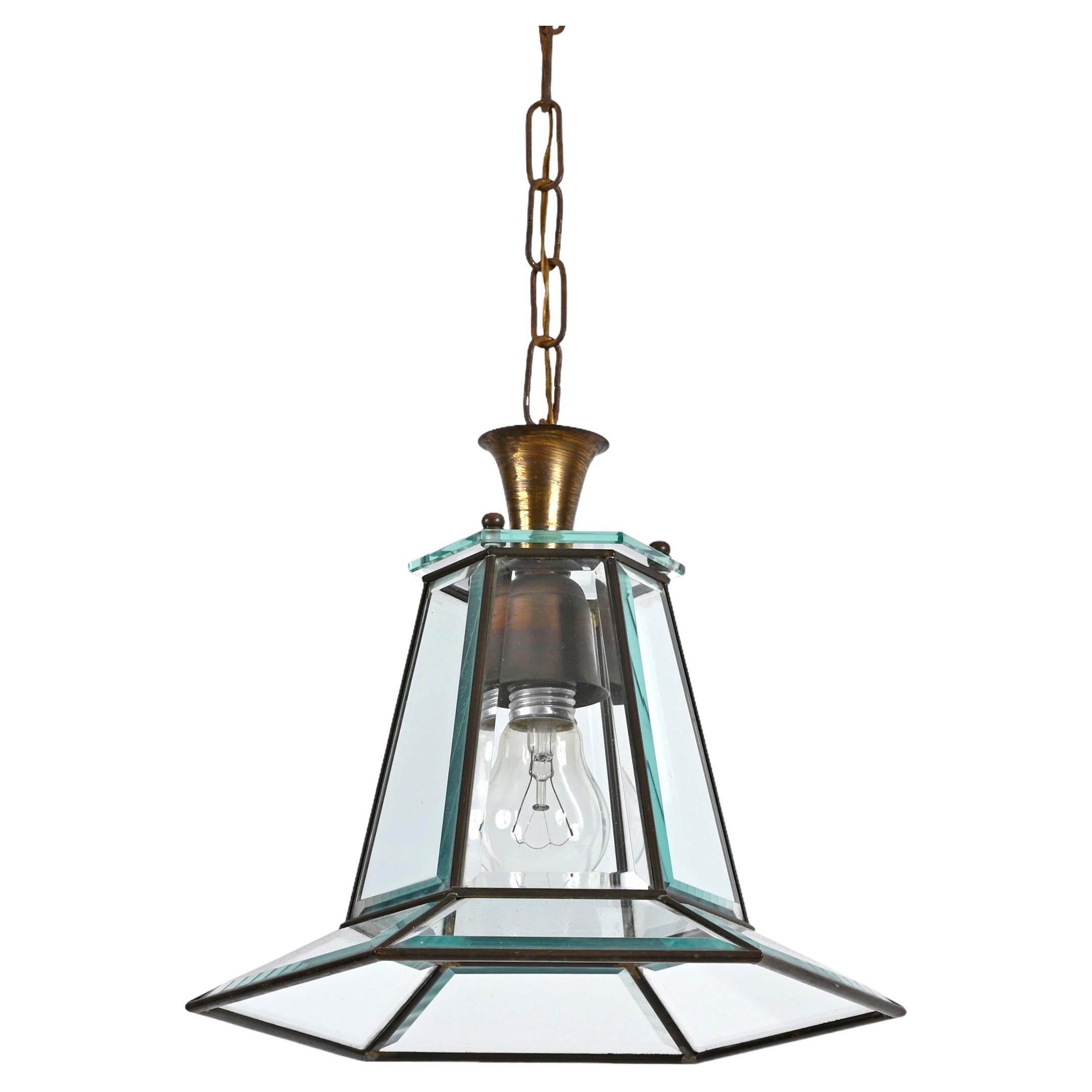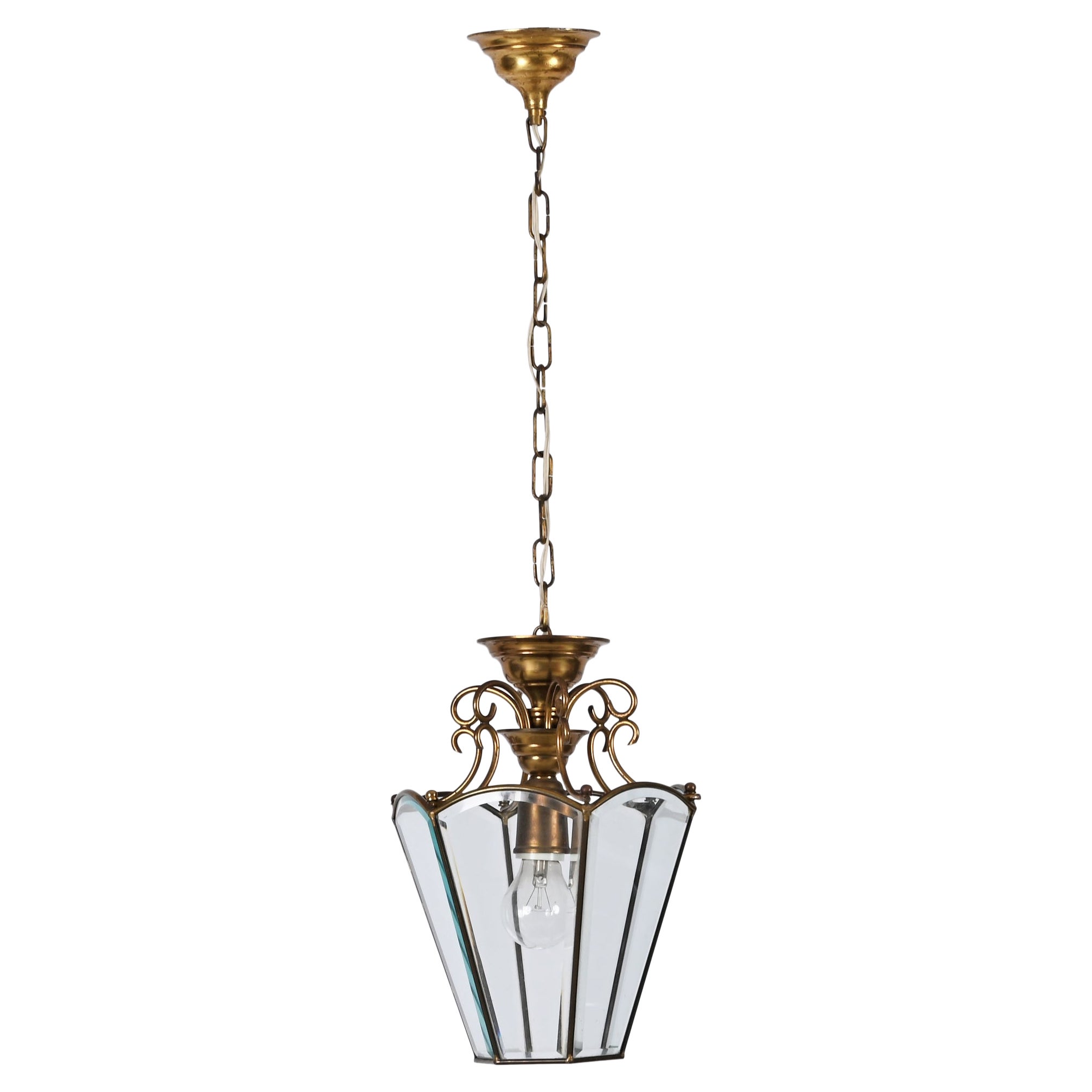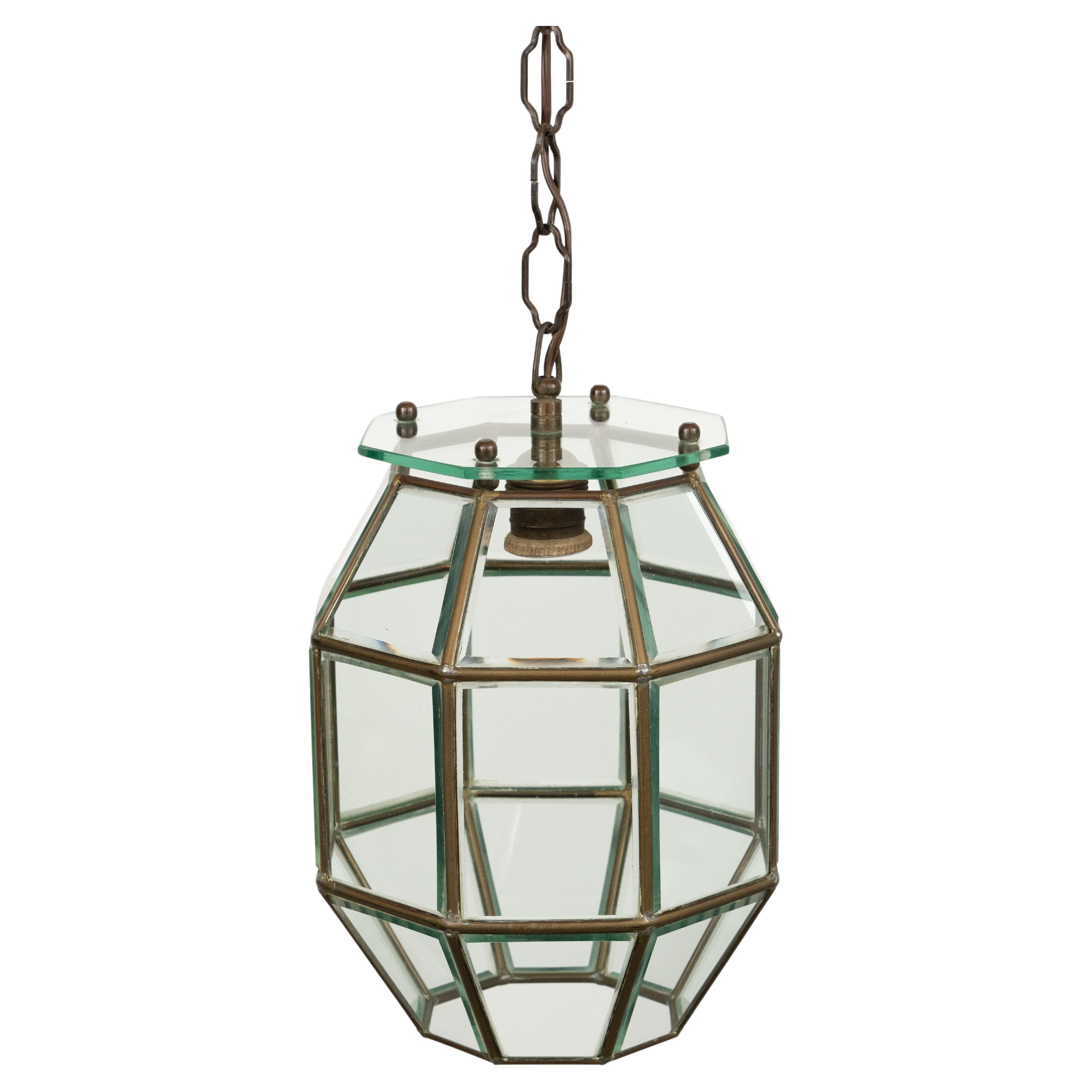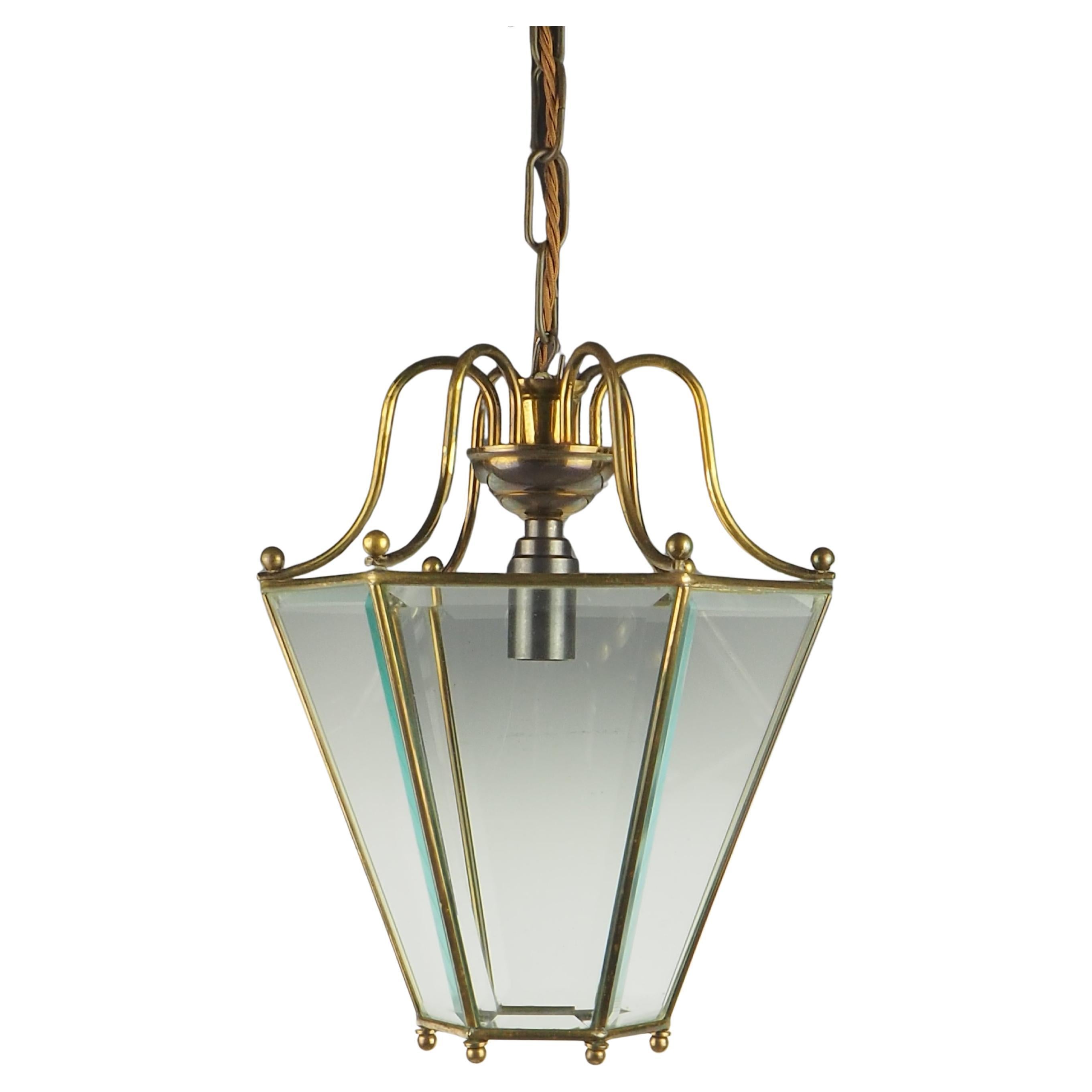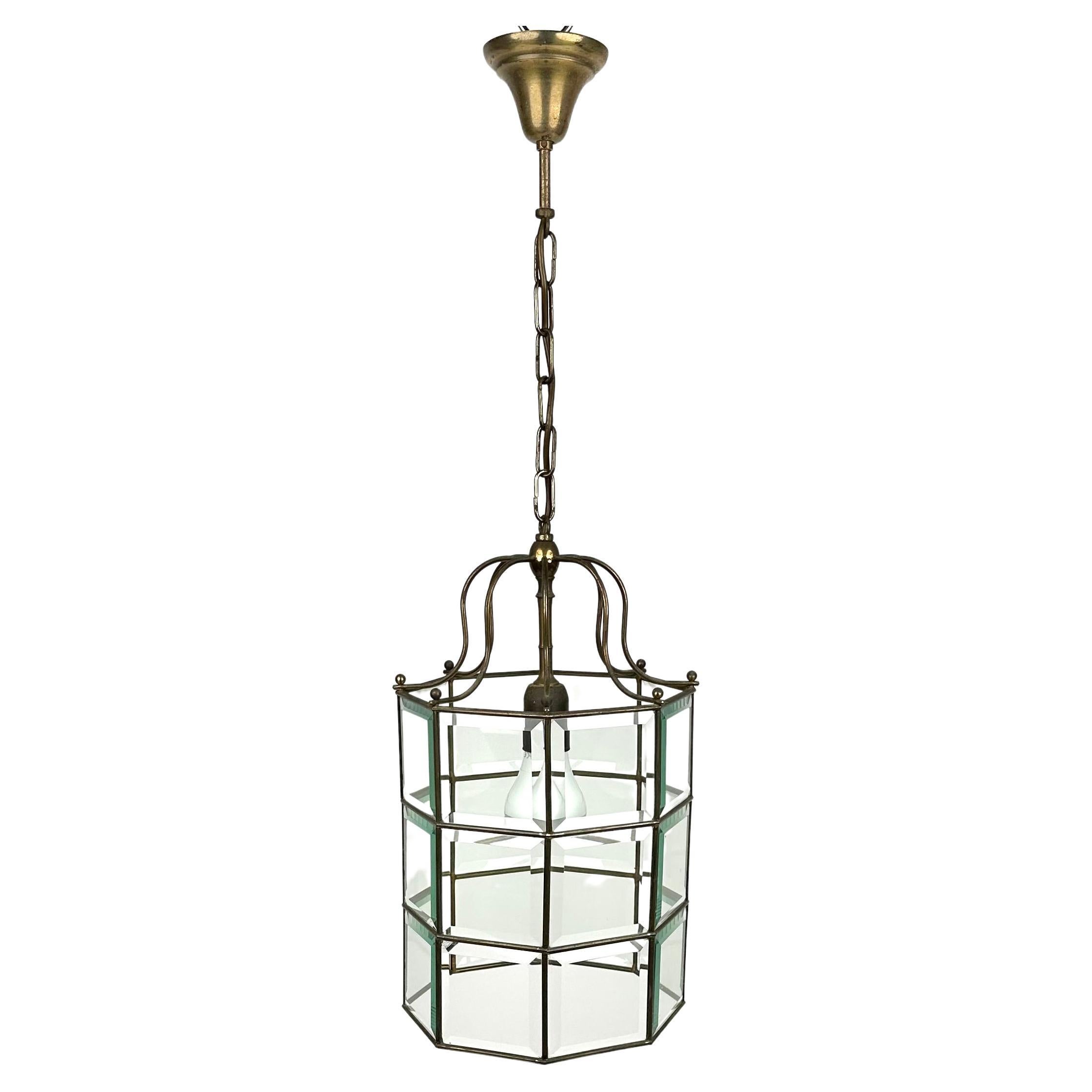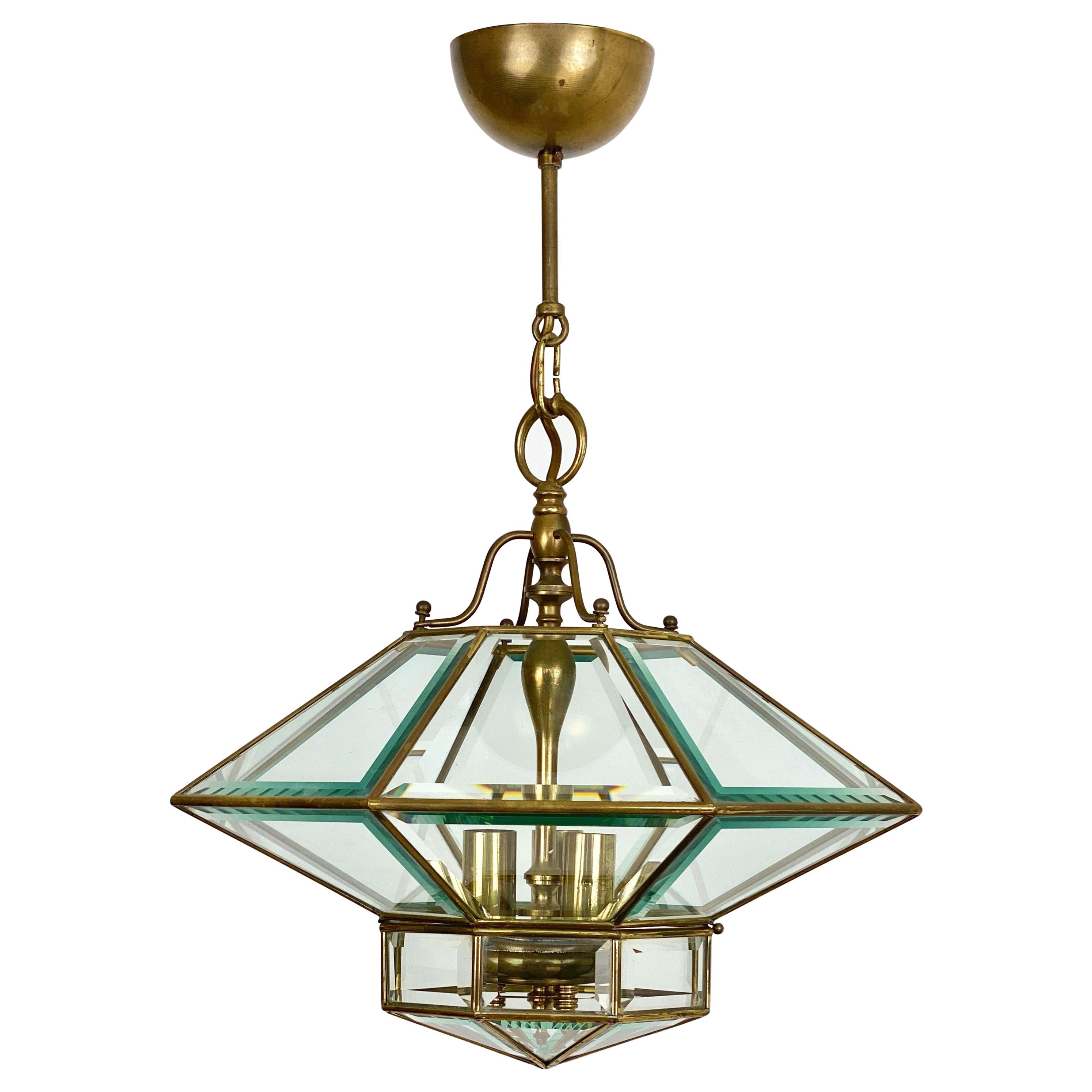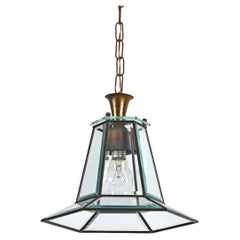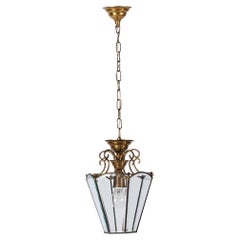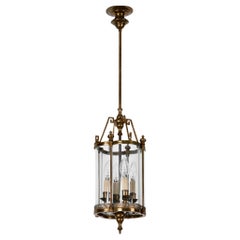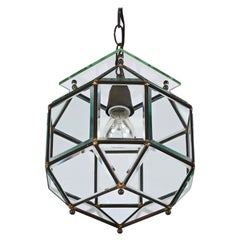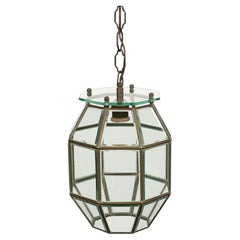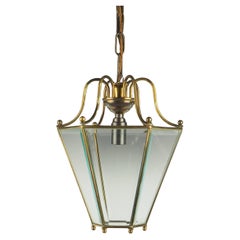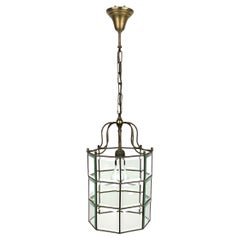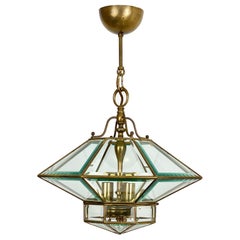Items Similar to Brass and Beveled Glass Hexagonal Italian Chandelier after Adolf Loos, 1950s
Want more images or videos?
Request additional images or videos from the seller
1 of 19
Brass and Beveled Glass Hexagonal Italian Chandelier after Adolf Loos, 1950s
$1,665.42
£1,233.78
€1,400
CA$2,290.69
A$2,547.90
CHF 1,336.63
MX$31,090.22
NOK 16,776.35
SEK 15,809.68
DKK 10,659.42
About the Item
Astonishing brass and bevelled glass hexagonal chandelier. This amazing pendant light was designed in Italy and inspired by the work of Adolf Loos during the 1950s.
This piece is fantastic thanks to a marvellous and clear suspension showing twelve faceted clear glasses in a brass frame. The bronzed patina of the brass frame is simply unique and gives the chandelier a stunning contrast.
Although minimal in its design due to the hexagonal shape and the well-patinated brass material, the pendant conveys astonishing complexity.
This chandelier will be the perfect item for a neoclassic entrance hall or an art deco living room.
This item is in excellent condition with some signs of ageing and used as a brass patina, it comes with an E27 socket.
Dimensions (cms):
Diameter - 21.5
Frame height - 30
Total height - 30
Adolf Loos (December 10, 1870 – August 23, 1933) was one of the most influential European architects of the late 19th century and is often noted for his literary discourse that foreshadowed the foundations of the entire modernist movement. As an architect, his influence is primarily limited to major works in what is now Austria and the Czech Republic, but as a writer he had a major impact on the development of 20th century architecture, producing a series of controversial essays that elaborated on his own architectural style by decrying ornament and a range of social ills. Adolf Loos’s minimalist attitudes are reflected in the works of Le Corbusier, Mies van der Rohe, and many other modernists and led to a fundamental shift in the way architects perceived ornamentation.
Born in Brünn in the Austro-Hungarian Empire (now Brno, Czech Republic) in 1870, Loos studied at the Royal and Imperial State Technical College in Reichenberg (now Liberec) until he left school to serve in the army for two years. Following this, he attended the College of Technology in Dresden and later moved to the United States for three years where he worked as a mason, a floor-layer, and a dish-washer. Eventually, Loos obtained a job working with architect Karl Mayreder in Vienna before establishing his own practice in 1897.
Through his writings, Loos desired to establish an intelligent method for designing buildings supported by pragmatic reasoning. His opposition to ornament extended to anything that could not be justified for its rational function. As a result, his buildings were often composed of pure forms and were justified by their economic practicality and utilitarian qualities. His theories on ornamentation were most succinctly revealed in an essay entitled Ornament and Crime in which he states “The urge to ornament oneself and everything within reach is the ancestor of pictorial art. It is the baby talk of painting... the evolution of culture marches with the elimination of ornament from useful objects.” Throughout the essay, he explored the notion that ornament results in the undue obsolescence of everyday objects, decrying the use of laborers and therefore financial capital for producing decorative details in contemporary buildings, and ultimately concluding that ornament was a sign of degeneracy.
His writings and architectural works sparked widespread furore, as they stood in sharp contrast to traditional Viennese design and more recent styles following the Vienna Secession and the Wiener Werkstätte. In writing a comparison between one of his most notable works and Josef Hoffman’s Apollo Candle Factory Shop, Loos alludes to the timeless qualities of architecture devoid of ornamentation: “The Cafe Museum, however, designed according to my principles and opened on the same date as the candle shop, will not become unusable until the glue no longer holds the furnishings together.”
Other notable buildings by Loos include his 1910 Goldman & Salatsch Building, overlooking Michaelerplatz, Vienna, as well as numerous private residences such as the Villa Müller in Prague. Many of his works, although controversial, revealed the roots of the modernist movement through their clean white walls and pure forms. Le Corbusier himself considered Loos’ Ornament and Crime "an Homeric cleansing" of architecture, revealing the magnitude of his impact on modernist ideology.
- Similar to:Adolf Loos (Designer)
- Dimensions:Height: 33.08 in (84 cm)Diameter: 8.47 in (21.5 cm)
- Style:Mid-Century Modern (Of the Period)
- Materials and Techniques:
- Place of Origin:
- Period:
- Date of Manufacture:1950s
- Condition:
- Seller Location:Roma, IT
- Reference Number:1stDibs: LU3067332017202
About the Seller
5.0
Platinum Seller
Premium sellers with a 4.7+ rating and 24-hour response times
Established in 1990
1stDibs seller since 2017
1,746 sales on 1stDibs
Typical response time: 1 hour
- ShippingRetrieving quote...Shipping from: Roma, Italy
- Return Policy
Authenticity Guarantee
In the unlikely event there’s an issue with an item’s authenticity, contact us within 1 year for a full refund. DetailsMoney-Back Guarantee
If your item is not as described, is damaged in transit, or does not arrive, contact us within 7 days for a full refund. Details24-Hour Cancellation
You have a 24-hour grace period in which to reconsider your purchase, with no questions asked.Vetted Professional Sellers
Our world-class sellers must adhere to strict standards for service and quality, maintaining the integrity of our listings.Price-Match Guarantee
If you find that a seller listed the same item for a lower price elsewhere, we’ll match it.Trusted Global Delivery
Our best-in-class carrier network provides specialized shipping options worldwide, including custom delivery.More From This Seller
View AllBrass and Beveled Glass Hexagonal Italian Chandelier After Adolf Loos, 1950s
Located in Roma, IT
Superb brass and bevelled glass hexagonal chandelier. This amazing pendant light was designed in Italy and inspired by the work of Adolf Loos during the 1950s.
This piece is fanta...
Category
Mid-20th Century Mid-Century Modern Chandeliers and Pendants
Materials
Brass, Metal
Brass and Beveled Glass Hexagonal Italian Chandelier After Adolf Loos, 1950s
Located in Roma, IT
Superb brass and bevelled glass hexagonal chandelier. This amazing pendant light was designed in Italy and inspired by the work of Adolf Loos during the 1950s.
This piece is fanta...
Category
Mid-20th Century Chandeliers and Pendants
Materials
Brass
Art Deco Brass and Semicircular Glass Italian Chandelier after Adolf Loos, 1950s
Located in Roma, IT
Superb brass and semicircular glass chandelier. This stunning pendant light was designed in Italy and inspired by the work of Adolf Loos in the 1950s.
This piece is fantastic than...
Category
Mid-20th Century Chandeliers and Pendants
Materials
Brass
Beveled Glass and Brass Italian Pendant Light, Fontana Arte Style, 1950s
By Fontana Arte
Located in Roma, IT
Fabulous pendant in beveled glass and brass. This gorgeous piece was designed in the 1950s and is attributed to Fontana Arte.
This marvelous pendant consist in a brass structure t...
Category
Mid-20th Century Italian Mid-Century Modern Lanterns
Materials
Brass, Metal
Italian Opaline Glass, Brass and Teak Chandelier Attributed to Stilnovo, 1960s
By Stilnovo
Located in Roma, IT
Amazing midcentury opaline glass brass and teak chandelier. This fantastic item is attributed to Stilnovo and was designed and produced in the 1960s.
This marvelous chandelier is...
Category
Vintage 1960s Italian Mid-Century Modern Chandeliers and Pendants
Materials
Brass
Opaline Glass Brass and Teak Italian Chandelier attributed to Stilnovo, 1960s
By Stilnovo
Located in Roma, IT
Amazing midcentury chandelier in opaline glass, brass and teak. This wonderful piece was attributed to Stilnovo and designed in the 1960s.
This beautiful lighting is in good vint...
Category
Vintage 1960s Italian Mid-Century Modern Chandeliers and Pendants
Materials
Brass
You May Also Like
Chandelier Lantern in Brass and Beveled Glass Adolf Loos Style, Italy 1950s
By Adolf Loos, Fontana Arte
Located in Rome, IT
Midcentury amazing octagonal chandelier lantern in brass and beveled glass in the style of Adolf Loos.
Made in Italy in the 1950s.
The stunning and clear cut pendant shows twen...
Category
Vintage 1950s Italian Mid-Century Modern Chandeliers and Pendants
Materials
Metal, Brass
Italian Brass and Beveled Glass Hexagonal Lantern After Adolf Loos, 1950s
By Adolf Loos
Located in Lincoln, GB
Italian Brass and Beveled Glass Hexagonal Lantern, inspired by the iconic designs of Adolf Loos from the 1950s, is a stunning pendant light that embodies the essence of minimalist el...
Category
20th Century Italian Chandeliers and Pendants
Materials
Brass
Brass and Beveled Glass Pendant Lantern Adolf Loos Style, Italy 1950s
By Adolf Loos
Located in Rome, IT
Chandelier Pendant Lantern in brass and beveled glass in the style of Adolf Loos.
The stunning and clear cut pendant shows twentyfour facetted clear glasses...
Category
Vintage 1950s Italian Mid-Century Modern Chandeliers and Pendants
Materials
Metal, Brass
Octagonal Diamond Chandelier Lantern Brass and Glass Fontana Arte Style, Italy
By Fontana Arte
Located in Rome, IT
Diamond-shaped chandelier lantern in a brass and glass structure in the style of the Italian designer house Fontana Arte. Made in Italy, circa 1960.
Category
Vintage 1960s Italian Mid-Century Modern Chandeliers and Pendants
Materials
Metal, Brass
Lovely Adolf Loos Lobmeyr Style Light Cut Glass and Brass, Austria 1930s
By Adolf Loos
Located in Nürnberg, Bayern
Lovely Adolf Loos Lobmeyr Style Light Cut Glass and Brass, Austria 1930s
Diameter: 11.03 in (28 cm)
Height: 36.62 in (93 cm)
Amazing Adolf Loos / Josef Hoffmann Style Vienna Secess...
Category
Vintage 1930s Art Deco Chandeliers and Pendants
Materials
Metal
Stylish Smoky Glass & Gilt Brass Chandelier, Germany
Located in Bastogne, BE
Unique chandelier from German manufactory JBS Leuchten is a wonderful combination of a long warranty and design work.
A spectacular chandelier is a worthy decoration of an exquisite interior. The base of noble BRASS creates a bright ensemble in combination with a GLASS lampshade, so that the chandelier looks really rich and stylish. The smoky glass...
Category
Mid-20th Century German Mid-Century Modern Chandeliers and Pendants
Materials
Bronze
More Ways To Browse
Italian Rational
Brass Neoclassical Chandelier
Imperial Glass Works
Beveled Glass Chandelier
Brass Baby
Hexagon Brass Chandelier
19th Century Pendant Light Brass Glass
Hoffman Dining
Empire State Building Vintage
Mies Van Der Rohe Signed
Vintage Beveled Glass Chandelier
Hungarian 19th Century Painting
Adolf Loos Glasses
Josef Hoffman
Italian Empire Chandelier
Beveled Glass Brass Chandelier
19th Century Austrian Chandelier
Hoffman Glass
